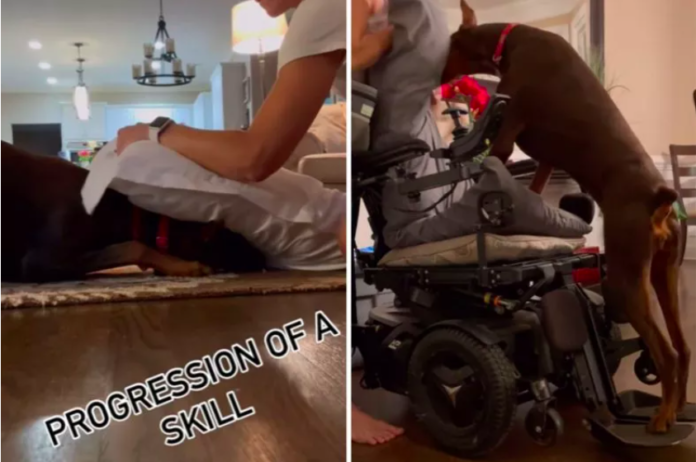Last Updated on May 18, 2024 by Fumipets
Training a service dog is a task that requires immense patience, persistence, and dedication. Megan Gentry and her husband Tyson embarked on this journey with their Doberman pinscher, Bailey, to help Tyson, a C-4 quadriplegic, regain some independence. The story of their success is both inspiring and informative for anyone interested in service dog training.
The Beginning of a Journey
Selecting the Right Dog
Tyson, who suffered a spinal cord injury during his sophomore year playing football at Ohio State University, has lived without a service dog for 18 years due to his allergies to Labradors, retrievers, and fine-haired dogs. Megan and Tyson decided to train a Doberman pinscher, Bailey, themselves, focusing on the dog’s traits of eagerness to please, resilience, and independence.
Training Bailey: The Push Command
Initial Training Steps
Megan began Bailey’s training with the “push” command to help Tyson sit back up if he leans too far forward. Initially, Bailey practiced pushing against a pillow to get comfortable with the movement.
Progressing to Real-Life Scenarios
Over time, Bailey progressed to practicing with the pillow in the wheelchair and eventually with Megan and Tyson. The training took months of consistent effort, with Megan nearly giving up at one point, doubting Bailey’s strength and size.
Challenges and Breakthroughs
Facing Difficulties
The training process was not without its hurdles. Bailey needed to learn to get her back feet on Tyson’s footrest for proper leverage, a task that took five months to master due to dogs’ natural aversion to unstable surfaces.
Support and Encouragement
Trainer Scot Rucker of Rucker Dog Training provided invaluable support and guidance, helping Megan stay motivated and focused on consistency, which is crucial in dog training.
Daily Training Routine
Mealtime Training
Megan utilized Bailey’s mealtimes for training sessions, integrating food incentives to reinforce commands. This consistent practice helped Bailey learn and retain her tasks effectively.
Building Trust and Skills
Through patience and repetition, Bailey learned to trust her training and her environment, which allowed her to perform her tasks reliably and confidently.
The Impact of a Service Dog
Increased Independence
Bailey’s ability to perform tasks such as picking up dropped items, closing doors, hitting handicapped buttons, and even assisting with shopping has significantly increased Tyson’s independence and reduced Megan’s caregiving burden.
Emotional and Practical Benefits
Having Bailey around has provided immense emotional and practical benefits. Tyson’s favorite command is “bring,” which allows him to call Bailey to pick up items and place them on his lap, showcasing the deep bond and trust between them.
The Realities of Training
Patience and Persistence
Megan emphasizes that dog training is rewarding but also frustrating. Her type-A personality clashed with the slow pace of training, but she learned to adapt and work with Bailey’s natural pace.
Learning to Adapt
Understanding that rushing the training process would only prolong it, Megan embraced the need for patience and adapted her methods to suit Bailey’s learning style.
Conclusion
Training a service dog is a journey filled with challenges and triumphs. Megan and Tyson’s story with Bailey highlights the importance of patience, persistence, and the incredible impact a well-trained service dog can have on a person’s life. Bailey’s training has not only provided Tyson with more independence but also strengthened the bond between them, proving that the effort and dedication are truly worth it.
FAQs Frequently Asked Questions
What are the key traits of a good service dog?
A good service dog should be eager to please, resilient, and independent. They should not scare easily and should be able to perform specific tasks reliably.
How long does it take to train a service dog?
Training a service dog can take several months to years, depending on the complexity of the tasks and the dog’s learning pace. Consistency and patience are crucial throughout the process.
Can service dogs be trained at home?
Yes, service dogs can be trained at home with the right guidance and resources. Professional trainers can provide support and advice to ensure effective training.
What are some common tasks that service dogs perform?
Common tasks include picking up dropped items, pushing wheelchairs, hitting handicapped buttons, closing doors, and providing emotional support.
What should you do if you face difficulties in training a service dog?
Seek guidance from professional trainers, stay consistent with training routines, and be patient. Adjusting training methods to suit the dog’s pace and comfort level is essential for success.
For more heartwarming and informative pet stories, visit Newsweek.


















